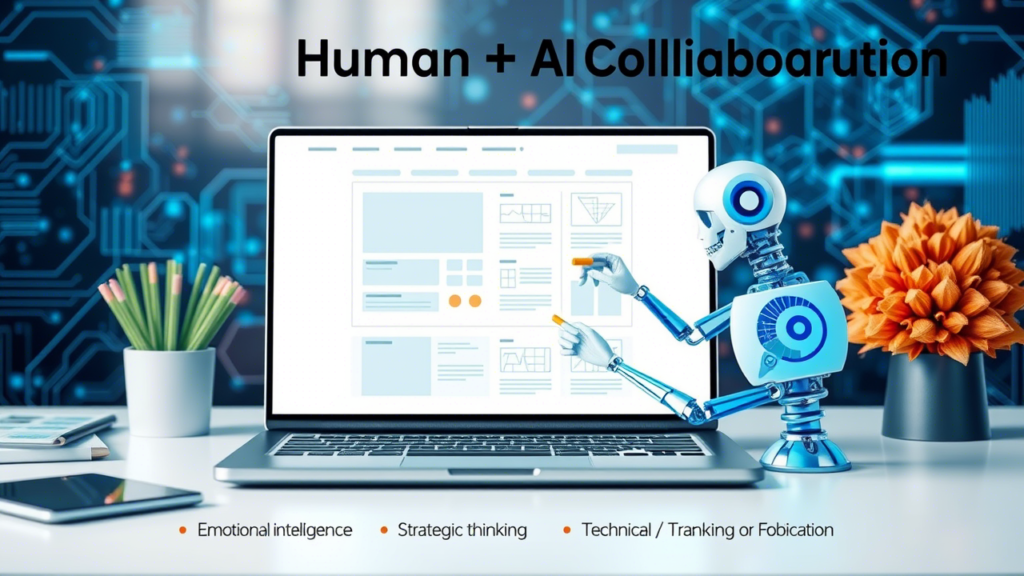In the rapid and fast paced evolving digital landscape, AI or artificial intelligence has emerged and transformed as a transformative force across industries. Web design, a field that blends creativity with technical expertise, now stands at this technological crossroads. As AI tools become more sophisticated, professionals and businesses alike are asking an inevitable question: Will AI eventually replace human web designers?
The Current State of AI in Web Design
Today’s AI-powered design tools can generate layouts, color schemes, and even complete website prototypes based on simple prompts. They analyze user behavior patterns, optimize interfaces for engagement, and suggest improvements backed by data rather than intuition alone.
These capabilities have already changed how designers work. What once required hours of manual coding and iteration can now be accomplished in minutes through AI assistance. Tools like Wix ADI, Adobe Sensei, and Grid.io use machine learning to create functional websites with minimal human input.
What AI Does Well
AI excels in several areas of web design:
Pattern Recognition: AI algorithms can analyze thousands of successful websites to identify common design elements that drive engagement and conversions.
Personalization: AI can dynamically adjust layouts, content, and user experiences based on individual visitor behavior and preferences.
Technical Optimization: From responsive designs that work across devices to image compression that boosts loading times, AI handles technical optimizations efficiently.
Data-Driven Decisions: AI removes subjective decision-making by relying on concrete user data to determine what works best.
The Human Elements AI Cannot Replace
Despite impressive advancements, AI faces fundamental limitations in web design:
Emotional Intelligence: Human designers intuitively understand emotional resonance, cultural nuances, and brand identity in ways AI cannot fully grasp.
Creative Innovation: AI primarily reconstructs and recombines existing patterns rather than creating truly novel approaches. Breakthrough design innovations still come from human creativity.
Strategic Thinking: Understanding a client’s business objectives, target audience psychology, and competitive landscape requires strategic thinking beyond algorithmic analysis.
Client Relationships: The collaborative process between designer and client builds trust and ensures alignment with business goals something AI cannot replicate.
The Evolving Designer Role
Rather than replacement, we’re witnessing a transformation of the web designer’s role. The most successful designers are embracing AI as a collaborative partner that handles repetitive tasks while allowing us, the humans to focus on strategic and creative directions.
Modern designers are becoming:
AI Conductors: Learning to craft effective prompts and direct AI tools toward desired outcomes.
Strategic Consultants: Focusing more on business strategy, user experience research, and brand alignment.
Experience Architects: Designing holistic user journeys beyond mere visual elements.
AI-Output Refiners: Adding the human touch to enhance AI-generated designs with creativity and emotional intelligence.
The SUM Group Approach: Human Expertise Enhanced by AI
At SUM Group, we’ve embraced this collaborative future by integrating cutting-edge AI tools with our team’s deep design expertise. Our web design services leverage AI capabilities while maintaining the irreplaceable human elements that create truly exceptional digital experiences.
Our approach includes:
AI-Augmented Design Process: We use AI to rapidly prototype concepts and analyze performance data, allowing our human designers to make informed decisions.
Strategic Client Partnerships: Our designers work closely with all clients to understand their unique business challenges and objectives, a human connection that AI cannot replicate.
Continuous Innovation: We invest in both AI capabilities and human creative development, recognizing that the most powerful solutions combine both.
The Future is Collaborative
The evidence suggests that the future of web design isn’t about AI replacing humans but about a powerful collaboration between the two. AI will continue handling increasingly complex technical tasks, freeing human designers to focus on strategy, innovation, and the emotional connections that drive meaningful digital experiences.
For businesses seeking web design services, the ideal partner isn’t one that simply deploys AI tools, but one that thoughtfully integrates artificial and human intelligence. At SUM Group, this balanced approach ensures our clients receive websites that are technically optimized, creatively distinctive, and strategically aligned with their business goals.
The question isn’t whether AI will replace designers, but how designers who effectively collaborate with AI will replace those who don’t. In this new landscape, the future belongs to those who embrace technology while honoring the irreplaceable value of human creativity.

